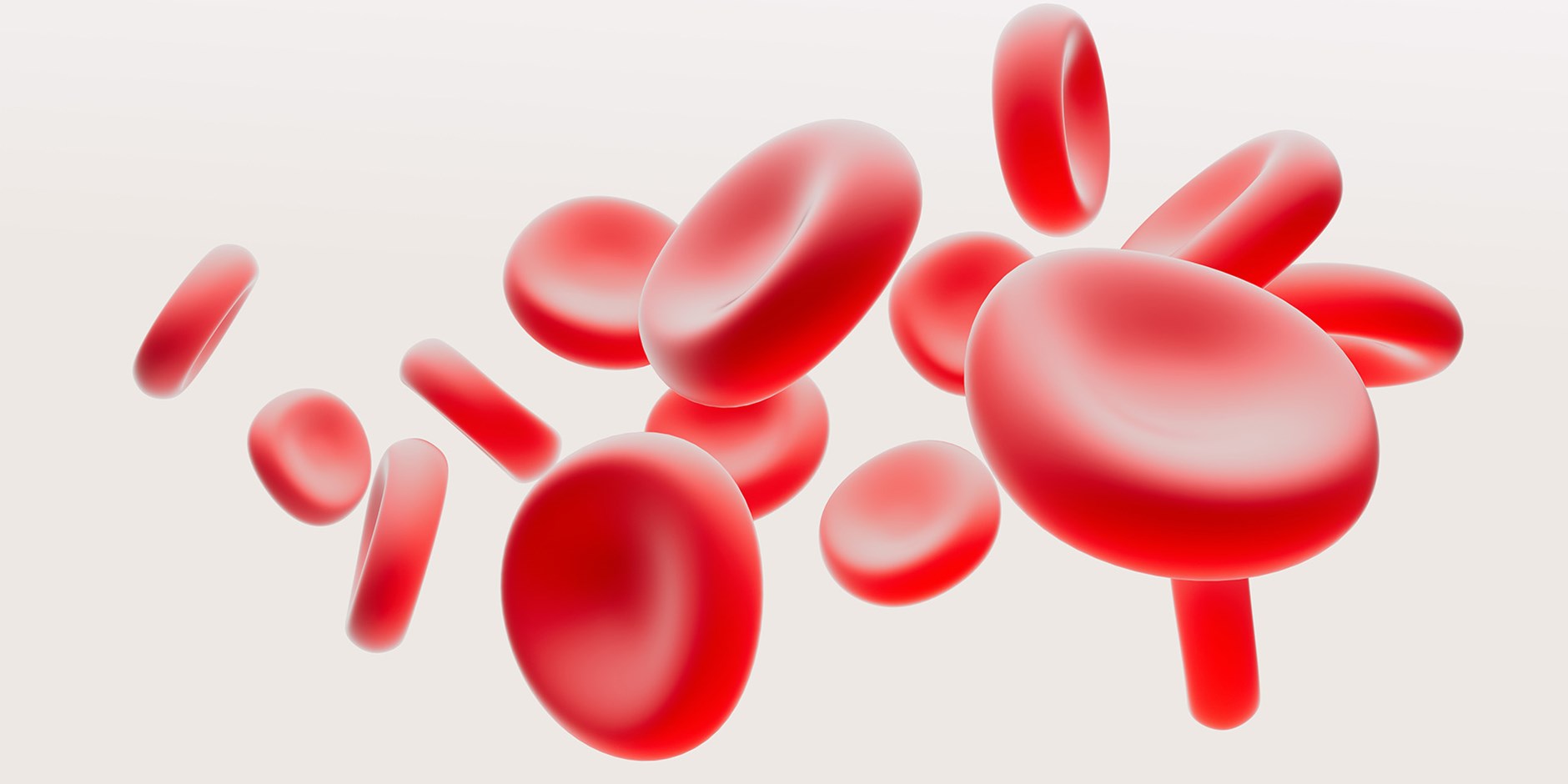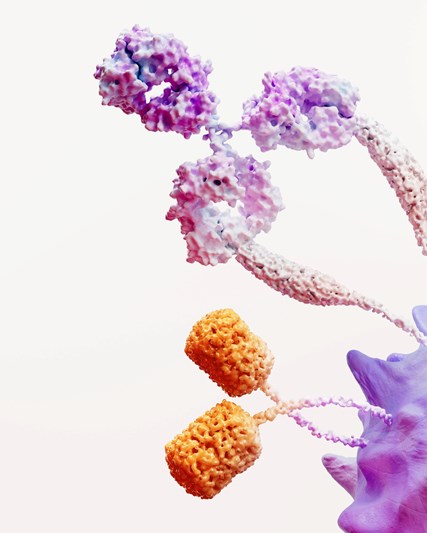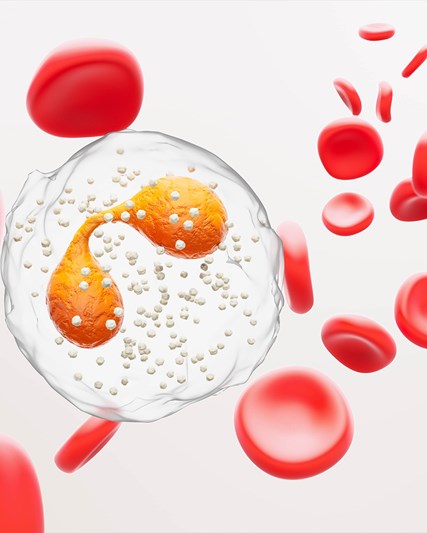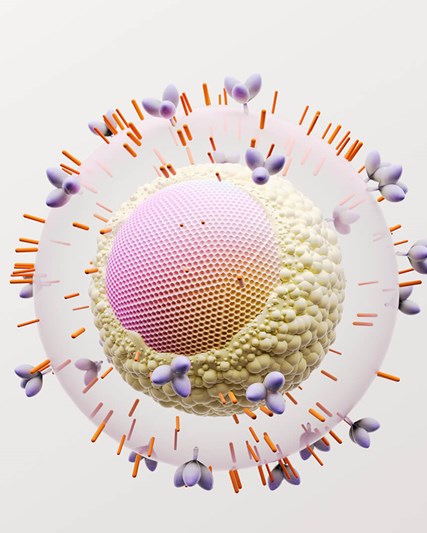US Specialty Health prioritizes research and development (R&D) and commercial investment in healthcare to transform immuno-inflammatory clinical practice and improve patient outcomes. We believe the predictive power of the immune system, human genetics, and advanced technologies such as artificial intelligence provide the greatest opportunity to improve patients’ lives.
Building on decades of research and a long-term commitment to innovative science, our focus on immuno-inflammation enables us to build portfolios in therapy areas where we can make a difference in patients’ lives and health care practitioner (HCP) practices. Our Specialty portfolio and pipeline represent an opportunity to improve the health of patients now and in the future.
Lupus and lupus nephritis
The Lupus Foundation of America estimates that 1.5 million Americans are living with a form of lupus.i The disease can be difficult to diagnose, even more challenging to treat, and is associated with a range of debilitating symptoms that can fluctuate over time.ii,iii
Systemic lupus erythematosus (SLE), or lupus, is a chronic disease that involves the immune system and can damage any part of the body.iv Normally, the immune system works to fight off invaders, such as viruses and bacteria, by making antibodies.iv With lupus, the immune system can’t distinguish between the invaders and healthy tissue, so it attacks and destroys the healthy tissue, causing inflammation throughout various parts of the body.iv Over time, this may cause organ damage.iv
Lupus nephritis (LN) is an inflammatory condition of the kidney caused by lupus.v As one of the most severe and potentially life-threatening manifestations of lupus, LN is expected to occur in approximately 40% of adults with lupus.vi Moreover, of those adults who develop LN, up to 20% will develop end-stage kidney disease (ESKD) in the 10 years after diagnosis.vii
Our work in and commitment to lupus and LN
GSK is committed to advancing treatment for people with lupus, one of the most complex autoimmune diseases, building on decades of research and leading with a long-term focus on innovative science.1 Our lupus experience stands strong on a wealth of clinical and real-world evidence. Given our commitment to lupus in the US, we continue to invest in and innovate for today and the future.
We understand lupus can affect patients differently and that many patients have unique needs. We strive to identify and pursue ways to help ensure patients have access to treatments and are committed to supporting patients and their families along complex disease journeys. And we look for opportunities to partner with patients, advocates and physicians to better understand their needs and to ensure GSK is able to show up strong for them.
Working in lockstep with the lupus community
Our partnerships with patients, advocates, and physicians hold the potential to impact millions of lives affected by lupus and LN. Because lupus is a chronic, complex and potentially isolating disease, we have a shared ambition with lupus advocacy organizations and patient groups to address unmet needs of people with this immuno-inflammatory condition.
Eosinophilic-driven diseases
Eosinophil-driven diseases are inflammatory conditions associated with high levels of eosinophils, a type of white blood cell.viii Everyone has eosinophils in their body which help to fight off some infections.viii They also accumulate at the site of allergic reactions.ix At normal levels, eosinophils work with other cells to help protect the human body and keep us healthy.
However, too many eosinophils in the bloodstream tissues, or organs can serve as a sign of eosinophilic inflammatory diseases. When eosinophils infiltrate certain tissues, they can cause inflammation and organ damage which, over time, can cause severe symptoms and significantly impact a patient’s life.viii. Eosinophils are now understood to play a complex role in a broad range of inflammatory diseases, including:
- Chronic Rhinosinusitis with Nasal Polyps (CRSwNP),
- Severe Eosinophilic Asthma (SEA),
- Chronic Eosinophilic Pneumonia (CEP),
- Eosinophilic Oesophagitis (EOE),
- Inflammatory Bowel Disease (IBD),
- Eosinophilic Granulomatosis with Polyangiitis (EGPA),
- Hypereosinophilic Syndrome (HES), and
- Atopic Dermatitis (AD)
Our commitment to personalized medicine
For patients living with an eosinophil-driven disease, a personalized approach is critical. Identifying eosinophilic inflammation in patients living with severe asthma is an important step in the evaluation process and may help patients with severe asthma.
GSK has been an established leader in eosinophil research for over 25 years. We are currently supporting more than 60 studies worldwide across 24 countries to progress eosinophil science and strive to treat more patients and target different eosinophil-driven diseases.
Our commitment to anemia of chronic kidney disease (CKD)
At GSK, we are dedicated to following the science of anemia of CKD and partnering with nephrology experts to better understand the challenges facing patients with anemia of CKD. We are dedicated to meeting their needs, helping improve their quality of life, and alleviating some of the burden of this condition on patients, caregivers, and the healthcare system.
Nobel Prize-winning science
In 2019, a trio of scientists, William Kaelin Jr (Dana-Farber Cancer Institute and Harvard University), Gregg Semenza (Johns Hopkins University), and Sir Peter Ratcliffe (Francis Crick Institute and Oxford University), were awarded the Nobel Prize in Physiology or Medicine. Their work, which spans more than two decades, greatly expanded our understanding of our body’s ability to sense and respond to different oxygen levels.1 Scientists then began to consider how this science could be harnessed in anemia of CKD.
CKD affects about 39 million people in the US 2
CKD, characterized by progressive loss of kidney function, is an increasing global public health burden.3 Risk factors for CKD include hypertension, diabetes, obesity, and primary renal disorders.3 Furthermore, CKD is an independent risk factor for cardiovascular disease.3 More than 1 in 7, that is, 15% of US adults or 39 million people, are estimated to have CKD.2,4
Anemia is a common complication of CKD
Anemia is an important and frequent complication of CKD.5 It is estimated that approximately 6 million US adults with CKD have anemia.2,6 It is often underdiagnosed and undertreated, especially in CKD patients not on dialysis.6 The prevalence of anemia (defined as hemoglobin <12 g/dL during one or more visits) increases with more advanced disease stages: 34% in stage 3a to 75% in stage 5.7 Anemia occurs in CKD when the erythropoietin (EPO) production is insufficient or because of the impaired ability to absorb and mobilize iron.8 When left untreated or undertreated, anemia of CKD is associated with poor clinical outcomes and can lead to a substantial burden on patients and healthcare systems.9
Real-world experience with anemia of CKD
Hear from Erich, a person living with anemia of CKD about his experience.
References
[i] Lupus Foundation of America. Lupus facts and statistics. www.lupus.org/resources/lupus-facts-and-statistics. Last accessed May 2022.
[ii] Lupus Foundation of America. Understanding lupus. www.lupus.org/understanding-lupus. Last accessed May 2022.
[iii] National Institute of Arthritis and Musculoskeletal and Skin Diseases. Systemic Lupus Erythematosus (Lupus). www.niams.nih.gov/health-topics/lupus. Last accessed May 2022.
[iv] Us in Lupus. What is Lupus? www.usinlupus.com/basics-of-lupus/what-is-lupus/. Last accessed May 2022.
[v] National Institute of Diabetes and Digestive and Kidney Diseases. Lupus and Kidney Disease (Lupus Nephritis). www.niddk.nih.gov/health-information/kidney-disease/lupus-nephritis#what. Last accessed May 2022.
[vi] GlaxoSmithKline. BENLYSTA. Understanding Lupus and Lupus Nephritis. www.benlysta.com/what-is-lupus/. Last accessed May 2022.
[vii] Tektonidou MG, Dasgupta A, Ward MM. Risk of end-stage renal disease in patients with lupus nephritis, 1971-2015: a systematic review and Bayesian meta-analysis. Arthritis Rheumatol. 2016;68(6):1432:1441.
[viii] American Partnership for Eosinophilic disorders (APFED). What is an Eosinophil-Associated Disease? https://apfed.org/about-ead/what-is-an-eosinophil-associated-disease/. Last accessed May 2022.
[ix] Rothenberg ME. Eosinophilia. N Engl J Med 1998; 338:1592-1600
[x] St Peter WL, Guo H, Kabadi S, et al. Prevalence, treatment patterns, and healthcare resource utilization in Medicare and commercially insured non-dialysis-dependent chronic kidney disease patients with and without anemia in the United States. BMC Nephrol. 2018;19(1):67.
[1] The Guardian. Nobel prize in medicine awarded to hypoxia researchers. Accessed October 27, 2022. https://www.theguardian.com/science/2019/oct/07/nobel-prize-in-medicine-awarded-to-hypoxia-researchers.
[2] GBD Chronic Disease Collaboration. Global, regional, and national burden of chronic kidney disease, 1990–2017: a systematic analysis for the Global Burden of Disease Study 2017. Lancet 2020;395:709–733.
[3] Hill NR et al. (2016) Global prevalence of chronic kidney disease – a systematic review and meta-analysis. PLoS One. 2016;11(7):e0158765. https://doi.org/10.1371/journal.pone.0158765.
[4] Centers for Disease Control and Prevention. Chronic Kidney Disease in the United States, 2021. Atlanta, GA: US Department of Health and Human Services, Centers for Disease Control and Prevention; 2021. Accessed October 27, 2022. https://www.cdc.gov/kidneydisease/publications-resources/ckd-national-facts.html.
[5] St Peter WL et al. Prevalence, treatment patterns, and healthcare resource utilization in Medicare and commercially insured non-dialysis-dependent chronic kidney disease patients with and without anemia in the United States. BMC Nephrol. 2018;19(1):67.
[6] Stauffer et al. Prevalence of anemia in chronic kidney disease in the United States. PLoS One. 2014;9(1):e84943.
[7] Wong MMY et al. Anemia and iron deficiency among chronic kidney disease Stages 3-5ND patients in the Chronic Kidney Disease Outcomes and Practice Patterns Study: often unmeasured, variably treated. Clin Kidney J. 2020;13(4):613–624.
[8] National Institute of Diabetes and Digestive and Kidney Diseases. Anemia in Chronic Kidney Disease. Accessed October 27, 2022. https://www.niddk.nih.gov/health-information/kidney-disease/anemia
[9] Hanna RM et al. Burden of anemia in chronic kidney disease: beyond erythropoietin. Adv Ther. 2021;38(1):52-75.





